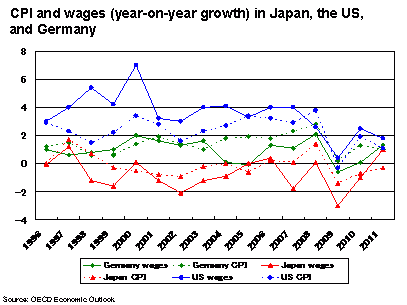No Japan-like Deflation in the US
Risaburo Nezu
Senior Executive Fellow
August 20, 2010 (Friday)
Speculation is mounting that the US will fall into the same kind of deflation as Japan. I believe the chances of this are slim. This is because wages have steadily declined in Japan since the late 1990s, while the US has seen a consistent rise in wages, albeit at a lower rate than before.
Deflation is a phenomenon unique to Japan
Deflation, or a continuous drop in the Consumer Price Index (CPI), is, with the exception of Japan, a phenomenon unseen in the developed world. Though inflation has been falling in the US and Europe, and there is no denying the impact of the recession, this is not the same as deflation. Why, then, has deflation persisted in Japan for so long? Popular explanations include the globalization-driven import of cheap products from China and other Asian countries, and lower costs in the overall economy from advances in information technology. These trends, however, are evident outside of Japan as well: The US and Europe are also flooded with cheap goods from Asia, with China imports coming to about 2% of GDP, roughly the same level as in Japan. Japan’s deflation, therefore, cannot be simply concluded as a product of globalization. Similarly, lower costs as a result of information technology are a common trend among developed countries. In fact, judging from the low ratio of information-related investment in overall business investment, Japan lags behind others in terms of cost-cutting through IT.
Falling wages are the real reason
As deflation is a phenomenon unique to Japan, its cause should also be singularly Japanese. As the graph illustrates, this cause is the consistent downward trend in wages observed only in Japan. Workers lose their purchasing power when wages fall. Companies respond by slashing prices to maintain sales volume. Absent improved productivity, lower prices inevitably lead to wage cuts to reduce costs. In this way, deflation and declining wages fall into a downward spiral—such is the Japanese phenomenon. The US and Europe have seen no such wage cuts; the US enjoys particularly high wage growth compared to Japan. Wage movements are important because services command 50% of the CPI in Japan and up to 60% in the US and Europe. In other words, the CPI of developed countries is affected more by the price of services than goods. And service prices are directly linked to wages. As personnel costs fall, so too does the price of services. In contrast, service prices, indeed prices in general, experience no decline when personnel costs are on the rise.

Falling wages are rooted in company-based unions and an increase in non-regular workers
Why have wages continued to fall in Japan? Among many reasons, the first and dominant view is that securing job opportunities is given priority in Japan, and a slight drop in wages is unavoidable to maintain employment. Behind this perspective is the problem that mid-career reemployment is difficult in Japan, and, even if successful, is disadvantageous in terms of wages. It is comparatively easier to switch jobs mid-career in the US, and American companies that cut wages risk losing their top talent. In Europe, the unionization rate is high with unions forming by functionality instead of by individual company, and a wage system is maintained uniformly in each country. It is therefore difficult for individual companies to slash wages based on their particular circumstances.
The second view is that the employment of cheap non-regular workers(1) has dramatically increased. These workers already represent a third of the entire Japanese workforce. Non-regular workers are also common outside of Japan, but the comparatively low wages of non-regular workers, who see half of what regular workers earn, is uniquely Japanese. No such disparity exists in other developed countries, where the principle of “equal pay for equal work” is maintained more rigorously, and, as a result, there is no incentive to replace regular workers with non-regular workers to save money.
In this way, idiosyncratic factors are at play behind falling wages and deflation in Japan, making it highly unlikely that the US will follow suit. As the graph illustrates, in 2008 other countries besides Japan and the US saw negative year-on-year CPI. However, this was generally due to a steep drop in oil prices, and cannot be considered fundamental deflation. The OECD and other major international institutions predict a drop in the CPI after 2010 for Japan only. The US has never seen negative wage growth on a year-on-year basis, and seems unlikely to in the future. Companies that fail to increase wages at all will likely lose employees. A wage hike would drive up prices primarily in the service industry, which represents 70% of all industries, thus preventing deflation. In fact, inflation stood at 2.1% in the first half of this year.
Necessary long-term and stable increase in wages
It becomes clear that maintaining a gentle rise in wages on par with other developed countries is necessary to overcome long-term deflation in Japan. Wages did not increase in Japan even during the longest period of economic recovery from 2002 to 2007, and the fruits of improved productivity were mostly stashed away as company profit. Low wages have allowed inefficient companies to survive in the service industry, which is comprised of a high number of small and medium-sized enterprises—this has delayed productivity improvement and reform of the industrial structure. The rapidly appreciating yen is currently battering the Japanese economy, and businesses are left with little leeway. When economic recovery shifts into full swing, however, it will become necessary to consider increasing wages and boosting the purchasing power of workers to combat deflation. This requires serious efforts to close the wage gap between regular and non-regular workers, and raise the minimum wage.
Notes
(1) Non-regular worker: Part-time, contract, and temporary workers.
